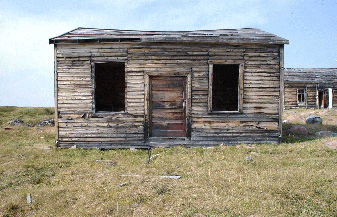Store / Warehouse
Recognized Federal Heritage Building
Ukkusiksalik National Park of Canada, Nunavut

South elevation of store and warehouse
© Parks Canada Agency / Agence Parcs Canada, 2011.
Address :
Wager Inlet HBC Post, Ukkusiksalik National Park of Canada, Nunavut
Recognition Statute:
Treasury Board Policy on Management of Real Property
Designation Date:
2010-11-29
Custodian:
Parks Canada
FHBRO Report Reference:
04-100
DFRP Number:
56578
Description of Historic Place
The former Hudson's Bay Company trading post at Ford Lake consists of three small wood frame buildings: the Store Warehouse, the Dwelling House, and the Tractor Depot. The three buildings are placed so as to outline a rough square, the fourth side of which is the north shore of the lake. Rough pathways loosely outlined in cobbles clarify the relationship of the buildings to the water and to each other. Sitting alone on the tundra, tilted this way and that and now coloured the brown and black of weathered wood they blend in with the stone and sparse vegetation of the landscape. They are, nevertheless, still the largest and most legible human elements in a cultural landscape rich in evidence of human habitation since ancient times.
The Store Warehouse occupies the west side of the square. As built it was a taut little white clapboard shed with a central door flanked by two windows symmetrically placed on the front façade and informally placed openings in the other sides. When the site was surveyed in 2004 there was a fragment of a double-hung six-over-six window on the site but no wall openings contained working windows. In 1926 two lean-to additions made the building into a "saltbox" form with an ell. It is now heavily weathered and partially collapsed, the three parts of its construction separated and leaning in different directions.
Heritage Value
The buildings of the former Hudson's Bay Company trading post at Ford Lake are “Recognized” Federal Heritage Buildings because of their historical associations, and their architectural and environmental values.
Historical value:
The former trading post illustrates the broad historical themes of Canada's fur trade, particularly the enduring domination of the trade by the Hudson's Bay Company well into the 20th Century, and the related theme of increasing Inuit involvement in management aspects of the fur trade. Further to the latter theme, the building is directly associated with Iqungajuq (aka Wager Dick or Native Dick) who participated in the construction of the post buildings, lived on the site and was well known in the region for his successful management of the trading post for the last half of its existence. Focusing on local development, the trading post is an excellent document of the profound shift of the Inuit economy and settlement patterns during the early 20th century from a nomadic way of life to a settled lifestyle engaged with the modern economy.
Architectural value:
The buildings of the former trading post are subtle variations within a deep-rooted vernacular of plain gabled forms with simple openings of standard proportions. Functionally, the buildings are a well-evolved response to a combination of environmental and commercial constraints: simple light timber and other construction materials bundled and shipped to a remote site and there quickly assembled by a small pool of not very skilled labourers. That the buildings still stand after many years of exposure to the harsh conditions of the Arctic demonstrates their fundamentally sturdy materials and effective assembly.
Environmental value:
Although the site no longer functions as a trading post, and no longer has a dock and privy, the intended relationship among the buildings, the land and the water is legible, reinforced by the footpaths that trace on the land the dynamic of the site when it was active. The setting is a wide expanse of tundra with many archaeological sites testifying to its long use by the Inuit. In that setting the buildings of the former trading post are still the dominant man-made elements, and thus give the setting much of its sense of place. A physical landmark inasmuch as it is visible at a distance, the former trading post is particularly important as a cultural landmark, well known to the communities of the region and embodying memory of how their way of life changed through the 20th Century.
Character-Defining Elements
The character-defining elements of the former Hudson's Bay Company Trading Post that should be respected include: Three buildings in simple gabled forms;
The buildings' prominence as the tallest, largest man-made things within sight;
Their proximity to navigable water;
The relationship among the three buildings and their relationship to the square they define;
Their expedient construction from pre-packaged material brought to the site from the south;
Stencils and handwritten labels on timbers identifying the lumber package;
Each shed's straightforward pattern of openings originally filled with standard five panelled doors or multi-paned glazing and wooden sash windows;
The clapboard siding, originally painted white;
The double sheathing, as a response to the harsh climate;
The loose stone footings, the only site-specific material in the construction;
In the Store Warehouse, the surviving display shelving;
The evidence of the square as a living and working environment distinct from the tundra: the paths and signs of the dock and privy; and
The expression of the trading-post functions in three buildings: storage, housing and machine support.